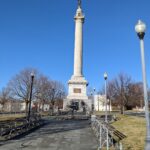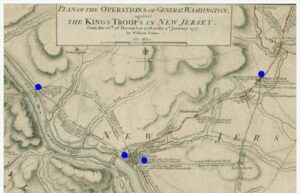Trenton Battle Monument
 The significance of Washington’s victory at Trenton made a lasting impression upon the British colonial secretary of state who, in 1779, told Parliament “…all our hopes were blasted by that unhappy affair at Trenton.”
The significance of Washington’s victory at Trenton made a lasting impression upon the British colonial secretary of state who, in 1779, told Parliament “…all our hopes were blasted by that unhappy affair at Trenton.”
This monument marks the site of the American artillery emplacement at the head of King (present day Warren) and Queen (present day Broad) Streets. These cannons commanded the two main North/South avenues of the city during the Battle of Trenton on December 26, 1776. General Washington had attacked the three Hessian regiments garrisoned in Trenton around 8 a.m. after crossing the river at Johnson’s Ferry the previous night and marching approximately nine miles through a winter storm. After a short battle, General Washington could claim his first battlefield victory. This victory boosted morale in both the Continental Army as well as the new nation often credited by historians as a turning point in the American War of Independence.
The monument, a 148 – foot high triumphal column of granite in the Roman -Doric style with a large base decorated with acanthus leaves and surmounted by a pedestal supporting a statue of General Washington directing troop movements, commemorates the American victory at Trenton. The monument came to fruition after years of planning by the Trenton Battle Monument Association when the cornerstone was laid on December 26, 1891 (the 115th Anniversary of the battle). The Association employed leading artists of the time to design and construct the monument. The monument was designed by John H. Duncan, architect of President Grant’s tomb. William O’Donovan contributed the statues of General Washington atop the pedestal, as well as John Russell of the 14th Continental Regiment and Blair McClenachan of the Philadelphia Troop of Light Horse flanking the main door at the base. Thomas Eakins created two of the bas-reliefs,” The Continental Army Crossing the Delaware River” and “The Opening of the Fight” that adorn the base of the monument. Finally, Karl H. Niehaus is credited with the last bas-relief entitled “The Surrender of the Hessians”. Reproductions have replaced the original bas-reliefs which are now housed in the New Jersey State Museum. The rear of the monument contains a historical tablet presented by the New Jersey Society of the Cincinnati.
A formal dedication ceremony was held on October 19, 1893, the 112th anniversary of British General Cornwallis’ surrender at Yorktown, Virginia. This monument continues today to remind visitors of the importance of General Washington’s great victory at the Battle of Trenton.

